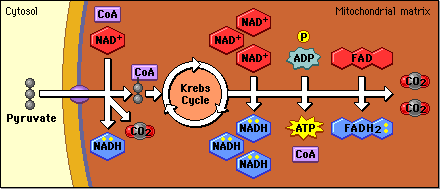|
Home
Cell Structure
and Function
Biomembranes
Photosynthesis
Cell
Respiration
DNA Structure
and Replication
Contacts
|
Cell Respiration
Concept 3:Krebs Cycle
The Krebs cycle occurs in the
mitochondrial matrix and generates a pool of chemical energy (ATP,
NADH, and FADH2) from the oxidation of pyruvate, the end product of
glycolysis.
Pyruvate is transported into the mitochondria and loses carbon
dioxide to form acetyl-CoA, a 2-carbon molecule. When acetyl-CoA is
oxidized to carbon dioxide in the Krebs cycle, chemical energy is
released and captured in the form of NADH, FADH2, and ATP.

  |